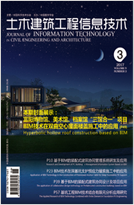2016, 8(5): 86-89. doi: 10.16670/j.cnki.cn11-5823/tu.2016.05.16
浅析BIM在消防设备管理中的应用
同济大学,上海 200092 |
Feasibility Study on BIM Technology in Fire Equipment Management
Tongji University, Shanghai 200092, China |
引用本文:
马建龙. 浅析BIM在消防设备管理中的应用[J]. 土木建筑工程信息技术,
2016, 8(5): 86-89.
doi: 10.16670/j.cnki.cn11-5823/tu.2016.05.16

Citation:
Ma Jianlong. Feasibility Study on BIM Technology in Fire Equipment Management[J]. Journal of Information Technologyin Civil Engineering and Architecture,
2016, 8(5): 86-89.
doi: 10.16670/j.cnki.cn11-5823/tu.2016.05.16

摘要:传统方法中,建筑物中的消防设备运维信息主要来源于纸质的竣工资料,需要用到这些信息时,往往要从海量的纸质图纸和文档中去查找。如果能采用电子化手段有效地组织这些信息,使设计和施工阶段的有效信息传递到运维期并辅助运维管理工作,那么建筑物的运维效率能得到很大的提升。本研究通过引入建筑信息模型和二维码技术,开发基于BIM的消防设备智能管理系统,借助BIM模型库和二维码标识实现了消防设备的电子化集成交付以,并运用智能移动设备辅助建筑物运维期的维护维修管理,为保障所有设备系统的安全运行提供高效的手段和系统平台支持。
Abstract: In the traditional method, the fire equipment operation and maintenance information of the building mainly comes from the completion data of the paper, that oftenwas searched from the mass of paper drawings and documents to find information you need. If do use electronic means to effectively organize the information, make usefulinformation of design and construction phase transfer to the operation period toassist operation and maintenance management, so the efficiency of operation and maintenance of buildings can be greatly improved. This study by introducing the building information model and QR code technology, developedan intelligent management system of fire protection equipment based on BIM, using the BIM model database and QR code identification realize the electronic fire equipment integrated delivery to mobile devices, and use intelligent mobile devices to assistmaintenance and management in operation period of building, provide efficient means and platform support system to ensure the safe operation of all equipment.
| [1] |
Korman T M, Fischer M A, Tatum C B, Knowledge and reasoning for MEP coordination. Journal of Construction Engineering and Management, 2003, 129(6): 627-634.doi: 10.1061/(ASCE)0733-9364(2003)129:6(627) |
| [2] |
Lite F, Akcamete A, Akinci B, et al. Analysis of modeling effort and impact of different levels of detail in building information models. Automation in Constraction, 2011, 20 (5): 601-609.doi: 10.1016/j.autcon.2010.11.027 |
| [3] |
Khanzode A, Ficher M, Reed D. Benefits and lessons learned of implementing Building Virtual Design and Construction(VDC) technologies for coordination of Mechanical, Electrical, and Plumbing (MEP) system on a large Healthcare project, Electronic Journal of Information Technology in Construction, 2008, 13: 324-342. |
| [4] |
Riley D R, Varadan P, James J S, el-al. Benefit-cost metrics for design coordination of mechanical, electrical and plumbing system in multistory buildings. Journal of Construction Engineering and Management, 2005, 131 (8): 877-889.doi: 10.1061/(ASCE)0733-9364(2005)131:8(877) |
| [5] |
Foms-Samso F, Bogus S M, Migliaccio G C. Use of Building Information Modeling(BIM) in facilities management. Ottawa, Canada, 2011. |
| [6] |
Yu K, Froese T, Grobler F. A development framework for data models for computer-integrated facilities management. Automation in construction, 2000, 9 (2): 145-167.doi: 10.1016/S0926-5805(99)00002-3 |
| [7] |
EI-Ammari K H. Visualization, data sharing and interoperability issues in model-based facilities management system. Montreal, Canada, 2006. |
| [8] |
Hassanain M A, Froese T M, Vanier D J. Development of a maintenance management model based on IAI standards. Artificial Intelligence in Engineering, 2001, 15 (2): 177-193.doi: 10.1016/S0954-1810(01)00015-2 |
计量
- PDF下载量(17)
- 文章访问量(1873)
- HTML全文浏览量(831)















